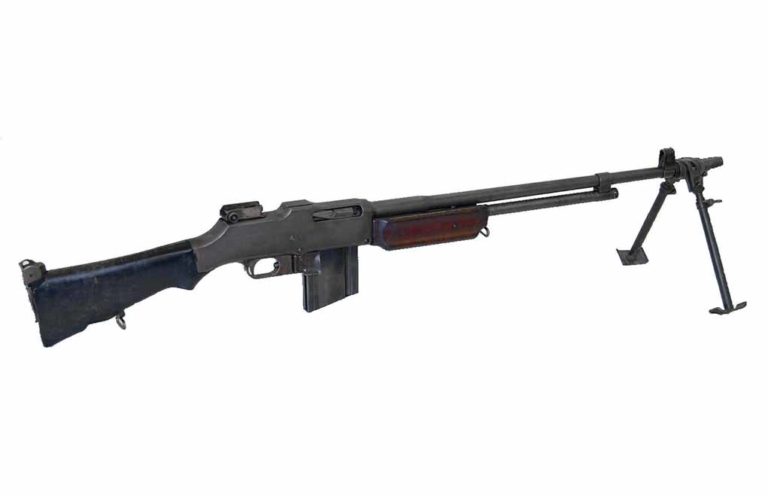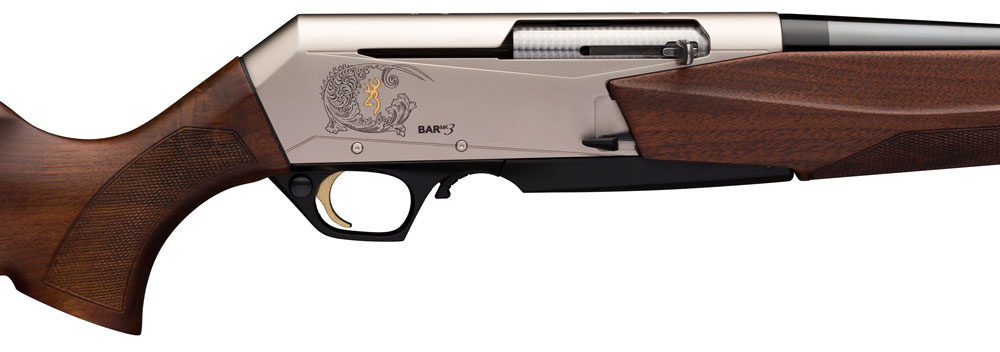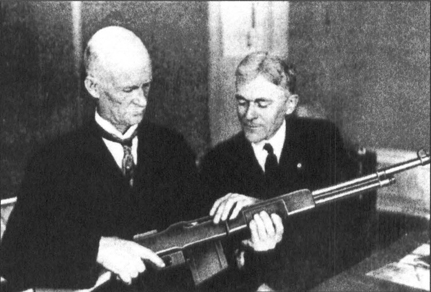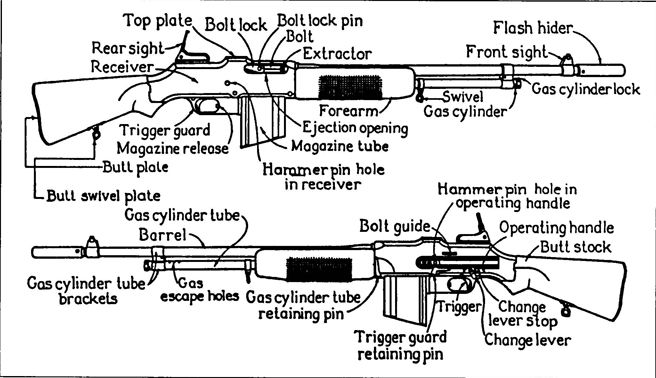

THE U.S. ARMY'S Browning Automatic Rifle, always known as the BAR, was one of the great infantry weapons of its day.
Browning BAR Military History
The Browning Automatic Rifle served in World War I, World War II, the Korean War and other conflicts, and some are still in military service.
The U.S. Army adopted the BAR in 1917 and retained it as a standard infantry weapon into the 1960s. From its introduction, this reliable and rugged weapon's accurate and effective fire changed the basic infantry organization and tactics of the U.S. Army and the Marine Corps.

The Browning Automatic Rifle began as another of the remarkable ideas of the amazing arms inventor John Moses Browning several years before World War I began.
He conceived it as an automatic rifle to complement the bolt-action rifles used by infantrymen of the day, but he did not develop it at the time because he realized the U.S. Army of the period would not want it.
Browning's BAR in World War I
Shortly after WWI began, in the fall of 1914, Browning began to develop his “automatic rifle” at the Browning Brothers' experimental gun machine shop in Ogden, Utah.
In late 1916, he demonstrated a prototype at the Colt factory in Hartford, Connecticut, and it worked very well. By this time, the U.S. Army was learning to use its existing machineguns in the troubles along the Mexican border, and they were interested in the new Browning's possibilities.
The Army first tested the BAR in February 1917, several months before the United States entered WWI in April 1917. Like so many Browning designs, it showed great promise, and Colt was encouraged to continue with its development, although the Army had neither the organization nor the tactics to use it at the time.

Then in May 1917, the Army adopted the BAR, even though its design had not yet been finished. At the time, no production facility or tooling to manufacture it existed.
Colt could not put the BAR into production quickly because they had massive military orders for their pistols, revolvers and machineguns — all critically needed at the front.
The Army negotiated a license with Colt which allowed them to assign production of the BAR to any manufacturer they selected. In September 1917, after several false starts and much confusion, Winchester got a contract manufacture it.
In early 1918, after testing the pre-production Winchester BAKs, the Army standardized the weapon as the “Cal. 30 Browning Automatic Rifle, Model of 1918.” At the same time, Colt and Marlin-Rockwell were also given BAR production contracts.
Winchester began delivering production BARs in June 1918, and Colt and Marlin-Rockwell deliveries began in late July 1918. Getting the BAR from prototype to production in about one year was one of the most successful WWI ordnance projects.
The first BARs reached the American Expeditionary Force, the A.E.F., in France in August 1918. They were desperately wanted to replace the marginal French Chauchat machine guns American troops were using in combat at the time.
Second Lt. Val A Browning, the inventor's son, went to France with the first BARs to demonstrate them, and he is supposed to have been the first person to fire one in combat.

The first Army unit to use the BAR in combat was the 79th Division in an action on September 13, 1918. While the BAR was an instant combat success, integrating it into the U.S. Army infantry organization was a major project.
Machine guns were regimental weapons in World War I, but the BAR became a company weapon. Originally, a U.S. Army WWI rifle company consisted of four rifle platoons. One of these was converted to a BAR platoon of three squads with two BAR sections each.
In combat, one BAR squad was assigned to each rifle platoon. At the end of the war, plans were being made to enlarge the BAR platoon so there would be one BAR for each eight-man rifle squad. This organization did not go into use because there weren't enough BARs or BAR men.
The BAR's Use By Infantrymen
Teaching a soldier to use and care for a BAR was not difficult. It was fired from the same prone, sitting, kneeling and standing positions as a regular infantry rifle.
In addition, the WWI BAR magazine belt provided a special pocket for the butt of the BAR which was used when firing from the hip in the “assault position.”
The 18-pound WWI Model 1918 Browning Automatic Rifle fired from an open bolt, and the forward movement of the bolt caused some aim disturbance. However, the BAR was a very accurate weapon, particularly when fired from any handy rest.
It could be fired in its semi-automatic manner, but it was found to be most effective firing short three- or four-round full-automatic bursts. Longer full-automatic bursts were inaccurate and a waste of ammunition.
Short bursts were easily fired by simply pulling and releasing the BAR's trigger quickly. This mode also kept the weapon from overheating.
The BAR saw relatively little combat in World War I, but it proved its worth beyond any doubt, so much so that it was one of the very few weapons kept in production after the end of World War I.
Some 102,125 BARs were built during WWI, and about half of them were delivered after the end of the war. At that point, Winchester had built 47,123; Marlin-Rockwell, 39,002; and Colt, 16,000.

The Army's WWI combat success of the BAR caused the British to consider adopting it, and they tested a version in their 303 rifle caliber. The French also considered adopting it in 30-06 caliber. Neither of these projects continued after the end of WWI.
At the end of that war, the BAR manufacturing rights reverted to Colt, and they manufactured BARs in the 1920s and 1930s for export military sales. The calibers included 6.5mm, 7mm and 8mm Mauser. Colt also built a special law enforcement “Monitor” version of the BAR and sold a few of them.
Foreign-Licensed Machine Gun Variants
In the 1920s, Browning licensed foreign manufacturers to build the BAR. FN of Belgium built it as their Model 30 and sold them to Belgian, Chilean, Chinese and other armies in limited numbers.
After World War II, FN reintroduced their BAR as the improved Model D with a quick-change barrel, something the U.S. Army never considered necessary or desirable. The FN Model D BAR in .30-06 caliber was used by the Belgian army, and the Egyptian army bought a number in 8mm Mauser caliber.
The Swedish government also bought a license to build BARs in 1920, and their army adopted it as the M21 in their 6.5mm. In the late 1930s they introduced an improved model with a quick-change barrel as their M37 BAR.
Poland also bought a license to build the BAR in the 1920s, and their army used them in 8mm as the Model 28. The Poles also built an experimental 8mm infantry rifle based on the BAR design, which they never placed in production.
In 1922, the U.S. Army adopted a modified BAR known as the “Cal. 30 Browning Machine Rifle M1922,” at the request of the Cavalry Board.
It was nothing more than a slightly heavier BAR with a finned barrel, bipod, and buttrest. This model was specifically for use with horse-mounted cavalry, and it became obsolete before World War II. Existing models were converted back to regular BARs.
All through the 1920s and 1930s, our Army worked on finding the best way to integrate the Browning Automatic Rifle into the infantry organization. By the end of the 1930s, two structures had been developed.
One was an infantry platoon with three eight-man rifle squads and a fourth eight-man squad with three BAR teams; that was standard at the end of the 1930s. The second approach involved a new, larger infantry platoon with four twelve-man squads, each with its own BAR team.
Extensive troop testing proved the twelve-man squad was tactically superior. It was adopted for Army and Marine Corps infantry in 1941, and it remained standard through WWII and as long after that as the BAR remained in service.
Early Improvements to Browning's Automatic Rifle
In the 1930s, the Army looked into improving the BAR. It was agreed the most effective fire was delivered prone, so a bipod was added and a hinged buttplate was provided to stabilize the gun in prone firing.
This version was adopted in June 1937 as the “Cal. 30 Browning Automatic Rifle M1918A1” and put in production by modifying existing M1918 BARs.
While both the M1918 and M1918A1 BARs were used in combat and for training until about 1942, a better gun, the “Cal. 30 Browning Automatic Rifle M1918A2,” was adopted for use in 1940.
This was the model used in WWII and thereafter, as long as the BAR remained in military service. Both M1918 and M1918A1 BARs were rebuilt as M1918A2s, and the M1918A2 was the WWII production model.
The M1918A2 BAR had some major changes from the earlier models: It had a bipod attached to its muzzle at its flash hider. A new forend with a metal heat shield was provided. Clip guides were added to the front of the trigger housing to improve magazine loading and survivability.
A completely new fire-rate-control buffer mechanism was installed in the buttstock, which allowed the BAR to fire selectively at full-automatic cyclic rates of 350 or 550 rounds per minute. The buttstock was also provided with a hinged fire support buttplate and a detachable butt support.
The M1918A2 BAR was in the hands of troops when WWII began for the U.S. armed forces. All of its modifications proved very successful except the buttstock support, which was no longer used by troops after 1943.

Very few changes were made to the BAR during WWII. An accessory carrying handle, the T4, was adopted in December 1942, but it was seldom issued during the war. It remained available as long as the BAR was standard, but it saw only limited service.
In 1942, a plastic stock for the BAR was developed because of stock-wood shortages and problems with rot encountered in jungle warfare.
At the end of WWII, a prong-type flash suppressor, the T35, was developed to replace the old tubular flash hider, but it was not extensively used until later during the Korean War.
The BAR Re-Enters Production During World War II
The huge expansion of the U.S. armed forces for WWII made it necessary to put the BAR back in production.
The project began by using the basic production tooling from Colt, Marlin-Rockwell and Winchester, which had been placed in storage after WWI. Deliveries of new BARs began in 1942, and 208,380 were built: 188,380 by New England Arms Co., a wartime company; and 20,000 by IBM.

The WWII supply of Browning Automatic Rifles was adequate to allow the Marine Corps to develop a special infantry organization around them for jungle combat. This was a four-squad rifle platoon with three BARs in each squad, or a dozen per platoon.
Each squad fought as three “fire teams,” each with its own BAR, and it proved very effective in jungle combat. While this organization was used in a number of Marine and Army infantry units during WWII, it was not used much after the end of the war.
Combat conditions, particularly in the jungles of the Pacific theater, caused BAR men to lighten their BARs.
They commonly took off the bipod, and sometimes the flash hider, to make the gun handier for jungle or street fighting, but this was never authorized. In open-country warfare, the bipod and flash hider were desirable since they allowed the BAR to deliver accurate and effective fire from the prone position to as far as 1000 yards.
From about 1942 until after WWII, the Army experimented with a number of weapons designed to be lighter “squad automatic weapons” than the BAR. A number of these were modifications of the standard M-1 Garand infantry rifle with selective full- or semi-automatic fire, but none of these proved satisfactory.
The Winchester Automatic Rifle designed by J.R. Williams of M-1 Carbine fame was more promising when tested in 1945–1946, but the end of the war precluded its adoption.

The Korean War Years
When the U.S. entered the Korean War in 1950, the Army used its latest and best WWII weapons and tactics, and the BAR was a main-stay of the infantry. Requirements for BARs for our armed forces, as well as those for United Nations allies such as the Republic of Korea, caused the weapon to be put back into production for one last time.
The Royal McBee Typewriter Co. manufactured 61,000 guns using tooling which had been saved at the end of World War II.
At the time of the Korean War, the U.S. was preparing to issue new infantry rifles to its armed forces in the new 7.62mm NATO caliber. While it was easy to convert the BAR to the new 7.62mm caliber, the Army did not do it because they considered the gun too heavy for their future squad automatic weapon.
At the same time, the Army experimented with a quick-change barrel feature for the BAR to make it more suitable for sustained fire as a light machinegun, but none of this type was ever produced.
BAR Competitors and the March to the Present

The Army adopted the new 7.62mm “Rifle M-14” for its infantry in May 1957. The M-14 fired selectively, and the bipod-equipped, heavy-barrel M-15 version was adopted as the squad automatic weapon (SAW) to replace the BAR.
As the M-14 rifles and M-15 SAWs went into service in the late 1950s, the M-l rifles and BARs they replaced were placed in “war reserve storage,” and by the early 1960s, the BAR had been retired from the U.S. armed forces.
However, many BARs had been given to various countries as military assistance, and they again saw service in the Vietnam War. Even today, the Browning Automatic Rifle is as rugged and reliable a weapon as there is, and they will still be found in service with some foreign armies.
This article appeared in the 1997 Edition of the annual Gun Digest book.
Bone Up On Browning:
- Browning Firearms: The 9 Best Gun Designs Ever (2020)
- Browning Hi Power: Eulogy and Final Farewell
- Browning Buckmark Review: Timeless .22 Rimfire Pistol
- Browning A5 Shotgun: The First Autoloader
- Browning Citori: The World’s Most Popular Over/Under Shotgun
- Is There A Better Browning BLR Than The Lightweight ’81 Takedown?
- Browning Shotguns: The Top 10 Greatest Ever!
UPDATE: The Browning Automatic Rifle Today

Today the Browning BAR not only remains in production, but the entire line has been modernized for both hunters and tactical shooters.
The 2020 Browning Automatic Rifle comes in a variety of configurations — eight to be exact — each available in a slew of modern chamberings ranging from .243 Win. up to .338 Win. Mag.
The Mark II Safari with BOSS uses Browning’s proprietary weighted muzzle brake system. It sports an attractive blued finish throughout with tasteful engraving on the receiver.
For western hunters, the lightweight BAR Hell’s Canyon Speed model has a burnt bronze Cerakote finish on metal parts with an A-TACS camo stock.
Barrel lengths span the gamut from 22 to 24 inches depending on caliber, which can be had from .243 Win. to .300 Win. Mag. The Hell’s Canyon model weighs from 6 lbs. 10 oz. in the smaller chambers to 7 lbs. 8 oz. in the big magnums.
To learn more, visit Browning at www.browning.com.
Corey Graff contributed to this article.

Next Step: Get your FREE Printable Target Pack
Enhance your shooting precision with our 62 MOA Targets, perfect for rifles and handguns. Crafted in collaboration with Storm Tactical for accuracy and versatility.
Subscribe to the Gun Digest email newsletter and get your downloadable target pack sent straight to your inbox. Stay updated with the latest firearms info in the industry.

![Best Concealed Carry Guns In 2025 [Field Tested] Wilson Combat EDC X9S 1](https://gundigest.com/wp-content/uploads/Wilson-Combat-EDC-X9S-1-324x160.jpg)


![Best 9mm Carbine: Affordable PCCs [Tested] Ruger Carbine Shooting](https://gundigest.com/wp-content/uploads/Ruger-Carbine-Shooting-100x70.jpg)
![Best AR-15: Top Options Available Today [Field Tested] Harrington and Richardson PSA XM177E2 feature](https://gundigest.com/wp-content/uploads/Harrington-and-Richardson-PSA-XM177E2-feature-100x70.jpg)
